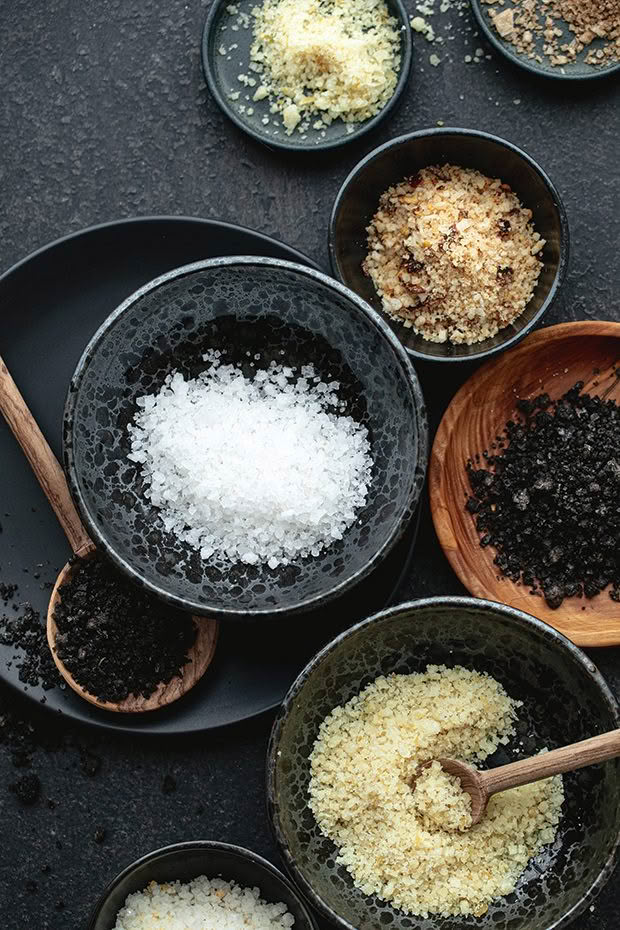The couple behind Northland’s award-winning salt are only just getting started

Seawater and sun are all James Moore needs to create his mineral-rich products.
Words Lee-Anne Duncan Photos: Manja Wachsmuth & Revised Edition
Few food producers can pack up and leave their farms for weeks. But then few food producers begin their production cycle barefoot on a sandy beach, a galvanised bucket in each hand.
In the heat of summer, every three days or so, James will drive the few kilometres from his home in Taipā in the Far North to Cable Bay, the next bay over. There, he’ll park up, take off his shoes and begin shuttle runs from the gently rolling seawater back to the truck, emptying each bucket of salt water into recycled olive barrels on the truck’s tray.
“If it’s just me, it takes only about 45 minutes. Not long,” James says. He jokes that he’s offered the job to the local gym, but it’s clear he rather likes doing it himself. Then, barrels filled, he drives home to rest the water for 24 hours before filtering it and running it into the dozens of food-grade plastic tanks that make up The Taipa Salt Pig’s solar-powered evaporation systems.
From there, salt production is generally about time and temperature. The sun’s heat evaporates the water in the trays, leaving pure mineral-rich sea salt crystals behind. These are then dried, packaged and sold under James and his wife Yasmin’s The Taipa Salt Pig brand, offering a range of plain and flavoured sea salts, as well as salt-adjacent offerings created with local artisans.

The Taipa Salt Pig, places & processes with James Moore. Natural Sea Salt farm in Taipa, Northland, NZ
If all farming is weather-dependent to an extent, salt farming is entirely so. James can turn out 70 kilogrammes or so of salt every two to three weeks in a year with lots of sun. The year before last was a good year, and he raked up 800 kilogrammes of salt. But 2022? Not so much. “We did only about 500 kilogrammes last year. It was very wet. I hope we can produce up to a tonne of salt this year,” he says. Winters are spent upgrading the evaporators, planning, or simply emptying the trays and taking off on holiday.
Being a salt farmer wasn’t something James saw for himself earlier this century. After a career in finance, he was based in Hamilton, importing excavators, but the 2008 Global Financial Crisis buried that business. James picked up a job as a postie, a role that gave him plenty of time to think. And he thought — what about salt?
With some Googling, James found a man in the United States with a story similar to his own who had built a solar-powered salt farm. James was intrigued. He drove out to Raglan, collected some water, returned home, and set up an evaporation system. It worked. “James became so fascinated with the process and the fact that there are so many different types of salt around the world. It became a challenge to him to see what we could do here,” says Yasmin.
That was back in 2009. Over the next few years, the couple wanted to make a go of making salt, so they packed up and moved to Taipā in the Winterless North.

They built their dream home, and James experimented with solar-powered evaporation systems. A decade after that first batch of salt, they launched The Taipa Salt Pig. Those who made salt were once rich, but Yasmin must still pull a full-time job — for now, anyway.
James started with a single 400-litre evaporator on their Taipā property. Now three evaporators can have 1200 litres of seawater evaporating away at any one time, yielding 70 to 80 kilogrammes of salt per batch.
Being an ideas man, James is constantly coming up with ways to produce more salt by decreasing the evaporation time. So now, while half the salt is still made the old way — by evaporation — the other half is helped along by a solar still. That innovation has also provided the pair with a new product.
“I was selling the salt at a market, and a couple of guys came up and said, ‘Wouldn’t it be great if you could capture the water vapour and use a solar still to make distilled water?’ I thought that was a great idea.
After collecting the seawater, I now put some of it through a solar still, which extracts freshwater from the seawater through evaporation and condensation.
“That process splits the seawater into two products. From 200 litres of seawater, we can capture 150 litres of freshwater. The remaining 50 litres is a highly concentrated brine that sits in our salt pans to finish off the process of making salt just like in the traditional way, but faster.” The freshwater is bottled in returnable, refillable glass and sold as (aptly named) Ocean Water.

“It has a unique flavour. It’s lovely and fresh but still has some minerality,” says Yasmin. “It’s also lovely when sparkling, so carbonisation is the next step. But we’re having trouble finding aluminium caps that fit the glass bottles well enough to seal in the carbonisation.”
Ocean Water won a silver medal at the 2022 Outstanding NZ Food Producer Awards.
“I entered thinking we might get a mention, but we won a medal,” says James, who sees enormous potential in the water. As devoted gin drinkers, part of that potential involves creating a gin. Be assured the couple is working on it.
SALT FOR EVERY SEASON
As well as plain sea salt, The Taipa Salt Pig offers an evolving range of flavoured salts, including the top-selling Citrus Zest Sea Salt, which won a gold medal at the 2022 Outstanding NZ Food Producer Awards. Other big sellers are garlic and chilli salts.
But the squid ink salt is one flavour that can take some getting one’s head around. “I wanted to make a black salt, so I experimented using squid ink. It’s my favourite. I love it. It’s particularly great on eggs, avocados and fish. But it is polarising,” says James. Yasmin’s favourite is smoked salt.
Creating each flavour takes a lot of experimentation, but generally, the flavours are added near the evaporation stage, when the salt has formed but is still wet. Just as with plain salt, the flavoured crystals are then dried.
The Taipa Salt Pig salts are finishing salts, designed to be sprinkled — “definitely not ground”, says James — onto food just before eating.
Yasmin’s advice is not to be afraid to add salt but also to remember a little of their salt goes a long way. “Commercial salts are coated in a compound, so they don’t hit the tastebuds immediately. In the meantime, we might add more salt because it’s bland. Our salts are immediately tasty, so only a few grains are needed, and less salt is used overall.”
Curry Basil & Broccoli Bisque

Taipa Salt Pig, recipe booklet. Recipes by Natasha MacAller, food styling & photography by Manja Wachsmuth. Props from The Props Department, Homeground, The Iron Clad Pan Company, Wonky Ware & Thea Ceramics
Serves: 4 to 6
INGREDIENTS
3 tablespoons olive or vegetable oil
125g onion, peeled and chopped
4 teaspoons medium-hot curry powder
100g leeks, washed, drained and sliced
50g carrot, chopped
50g celery, chopped
25g garlic, chopped
1 apple, peeled, cored and chopped
250g potato, cooked
1 litre vegetable or chicken stock
500g broccoli, roughly chopped
1 large bunch basil leaves, roughly chopped
120ml cream
1 teaspoon lemon juice
2 teaspoon sugar
1 teaspoon The Taipa Salt Pig Citrus Zest sea salt
1 teaspoon The Taipa Salt Pig Garlic sea salt
crispy fried shallots or onions, and flash-fried
curry leaves, to garnish
METHOD
Heat the oil over medium heat in a large (approximately 4-litre) pot. Add the onion, stirring to coat and cooking for 5 to 6 minutes until softened.
Add the curry powder and stir for about 2 minutes, then add the leeks, carrot, celery, garlic and apple, stirring occasionally until all ingredients are softened. Add the potato, stock, broccoli and basil, and pour in 500ml of water. Stir to combine, then put a lid on top and bring to a gentle simmer, stirring occasionally until the vegetables are tender.
Add the remaining ingredients, except for the garnishes. In a blender, blend until smooth, rich and creamy. Season to taste with additional citrus zest and/or garlic salt and freshly ground pepper, and top with a sprinkling of crispy fried shallots or onions and several flash-fried curry leaves.
Best served with a chunk of toasty garlic bread on the side.
Love this story? Subscribe now!
 This article first appeared in NZ Life & Leisure Magazine.
This article first appeared in NZ Life & Leisure Magazine.
